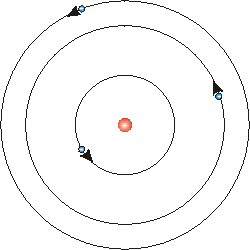Quantized energy levels
Created by Keller Porter
Claimed for Revision by Jonathan Ledet Fall 2016
The Main Idea
The electrons around an atomic nucleus are held in orbit by an electric field (created by the positively charged protons interacting with the negatively charges electrons). The atom behaves in such a way that there is only certain spaces, called 'stationary orbits', in which electron orbits can happily exist. This behavior occurs due to the wave-particle duality of electrons and results in a formulaic and regular behavior of energy levels in each stationary orbit. Because the energy levels of each orbit are not a continuous spectrum, and rather exist at discrete values, they are said to be 'quantized'. Quantization is a transition from a classical understanding of physical principles to a more modern understanding.
The various levels of energy associated with an atom are described using its principle quantum number (often denoted as [math]\displaystyle{ n }[/math]). A principle quantum number [math]\displaystyle{ n }[/math] of 1 indicates that the electron is in the orbit (or 'shell') closest to the nucleus; this state is of the lowest energy level and is referred to as the 'ground state'. A principle quantum number of greater than 1 indicates an electron in a larger orbit and higher energy level; this state is referred to as 'excited'.
A Mathematical Model
The energy of each level can be found using the formula:
[math]\displaystyle{ E_n = \frac{-2\pi^2me^4Z^2}{n^2h^2} }[/math]
where [math]\displaystyle{ m }[/math] is the mass of an electron, [math]\displaystyle{ e }[/math] is the magnitude of the electric charge, [math]\displaystyle{ n }[/math] is the principle quantum number, [math]\displaystyle{ h }[/math] is Planck's constant, and [math]\displaystyle{ Z }[/math] is the atomic number of the atom. This gives the energy for a specific atom at each energy level. The value will always be negative because electrons in the electron cloud are in a bounded state, so the potential energy is negative.
While the value for each energy level is set in place, the energy of each individual electron can change. This can happen either by an interaction with another electron or a photon. For an electron, they can jump from the ground state to the fourth level if [math]\displaystyle{ E_{particle} \ge E_4-E_1 }[/math]
A Computational Model
Example: Hydrogen Model
Research done by Johannes Rydberg showed that hydrogen has a ground level energy of [math]\displaystyle{ E_R = 13.6eV }[/math]. With Rydberg's constant, the initial formula for energy levels can be altered to include this. This new formula is:
[math]\displaystyle{ E_n = \frac{-E_R}{n^2} }[/math]
Basic Level Calculation
Find the energy level for the level [math]\displaystyle{ n=6 }[/math].
Solution: [math]\displaystyle{ E_6 = \frac{-13.6}{6^2} = -.378eV }[/math]
Level Change Calculation
Will an electron with energy [math]\displaystyle{ E_{electron} = 10.4eV }[/math] be able to bump a hydrogen electron in the ground state to the second level?
Solution: [math]\displaystyle{ E_1 = \frac{-13.6}{1} = -13.6eV }[/math]
[math]\displaystyle{ E_2 = \frac{-13.6}{2^2} = \frac{-13.6}{4} = -3.4eV }[/math]
[math]\displaystyle{ E_2 - E_1 = -3.4eV - -13.6eV = 10.2eV }[/math], so it requires [math]\displaystyle{ 10.2eV }[/math] to bump an electron from the ground state to the second level.
[math]\displaystyle{ 10.4eV \ge 10.2eV }[/math]
Yes, the electron has enough energy to bump the electron from the ground state to the second energy level.
Implications
Until quantization of atomic energy levels occurred, there were a few different experiments that had already been performed that did not make sense. Once researchers discovered the actual way electrons make up the electron cloud as well as the mechanisms that help them jump from level to level, these experiments could be explained. Readings for these three experiments can be found below.
History
In the 1814, Joseph von Fraunhofer and William Hyde Wollaston discovered that when viewed closely, the spectrum from sunlight contained dark lines. These lines represented wavelengths of sunlight that were not reaching us. These wavelengths were being absorbed by the sun's atmosphere.

In 1911, Rutherford came up with his model for the atom. It used all the same components of an atom that we know exist today, but it had one glaring issue. His model lacked stability. Classical electromagnetic theory said that the electrons surrounding the nucleus would quickly collapse because they were emitting electromagnetic waves, causing them to lose energy. If this were true, then the atom as we know it would not be able to exist.
Bohr's model of the atom solved this problem. He proposed that the laws of classical mechanics must be reconsidered. His model said that the electron cloud had stationary orbits, a specific set of orbits for electrons. This differed from the assumption that the electron cloud was just a continuum where the electrons were free to orbit the nucleus. His model was similar to the solar system in that electrons orbit the nucleus like planets orbit the sun. Electrons are held in place by electrostatic forces, and planets are held in place by gravitational forces. The base energy level, called the ground state, is the first stationary orbit. From there, there can be many more levels. The energy of each level can be denoted [math]\displaystyle{ E_n }[/math], [math]\displaystyle{ n=1,2,3... }[/math]. At the ground state, the energy required to free the electron is greatest. It requires a specific level of energy to excite an electron to another energy level, and energy can be released to bring the electron back down to the ground state.
References
- http://hyperphysics.phy-astr.gsu.edu/hbase/bohr.html
- http://www.chemistry.mcmaster.ca/esam/Chapter_3/section_1.html
- http://www.colorado.edu/UCB/AcademicAffairs/ArtsSciences/physics/TZD/PageProofs1/TAYL05-144-167.I.pdf
- "Emission spectrum-H" by Merikanto, Adrignola - File:Emission spectrum-H.png. Licensed under CC0 via Commons - https://commons.wikimedia.org/wiki/File:Emission_spectrum-H.svg#/media/File:Emission_spectrum-H.svg
- "Fraunhofer lines" by Fraunhofer_lines.jpg: nl:Gebruiker:MaureenVSpectrum-sRGB.svg: PhroodFraunhofer_lines_DE.svg: *Fraunhofer_lines.jpg: Saperaud 19:26, 5. Jul. 2005derivative work: Cepheiden (talk)derivative work: Cepheiden (talk) - Fraunhofer_lines.jpgSpectrum-sRGB.svgFraunhofer_lines_DE.svg. Licensed under Public Domain via Commons - https://commons.wikimedia.org/wiki/File:Fraunhofer_lines.svg#/media/File:Fraunhofer_lines.svg
- http://venables.asu.edu/quant/Dinesh/Bohratom2.html (bohr atom)
- "Energy levels" by SVG: Hazmat2 Original: Rozzychan - This file was derived from: Energylevels.png. Licensed under CC BY-SA 3.0 via Commons - https://commons.wikimedia.org/wiki/File:Energy_levels.svg#/media/File:Energy_levels.svg